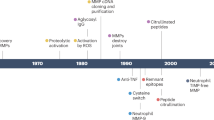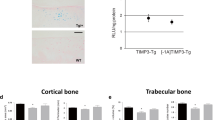Abstract
Metalloproteinases such as the matrix metalloproteinases (MMPs) and disintegrin-metalloproteinases with thrombospondin motifs (ADAMTSs) have been implicated in the pathological destruction of joint tissues in rheumatoid arthritis and osteoarthritis. These enzymes degrade extracellular matrix macromolecules and modulate factors governing cell behavior. They may also be involved in tissue repair, but become a part of the destructive disease process due to overexpression. Studies investigating the roles of metalloproteinases have thrown light on the failure of the early clinical trials of MMP inhibitors as therapeutic agents in arthritic diseases. It is now clear that a more accurate knowledge of the enzymes in the different cells and their precise roles in the disease process is required for these approaches to be successful. The next generations of metalloproteinase inhibitors should have added specificity, gained from an understanding not only of the catalytic domain structures but the role of extracatalytic motifs in substrate binding, or by the generation of engineered tissue inhibitors of metalloproteinases. Inhibition of the enzymes by modulating gene expression or preventing protein activation could also be considered. Work on the development of effective biomarkers is also essential before an effective evaluation of the new generations of specific inhibitors can be made.
Key Points
-
Matrix metalloproteinases and disintegrin metalloproteinases with thrombospondin motifs elevated in joint tissues in rheumatoid arthritis (RA) and osteoarthritis (OA) are the key enzymes that degrade the extracellular matrix of cartilage
-
In RA metalloproteinases are derived primarily from inflammatory cytokine stimulated synovial lining cells, whereas in OA the enzymes arise from chondrocytes and inductive stimuli include mechanical stress, tissue injury, oxidative stress, degraded matrix, joint destabilization and aging, as well as inflammatory cytokines
-
Clinical trials of matrix metalloproteinases inhibitors have not been successful, probably because of the lack of selectivity of the inhibitors. Highly selective, nontoxic compounds are essential for metalloproteinase inhibitor therapy of arthritis
-
It may be possible to develop of selective inhibitors based on molecules that interact with the exosite of the enzyme, allosteric inhibitors, or engineering of tissue inhibitors of metalloproteinases
-
Biomarkers to monitor the in vivo efficacy of metalloproteinase inhibitors are necessary
This is a preview of subscription content, access via your institution
Access options
Subscribe to this journal
Receive 12 print issues and online access
$209.00 per year
only $17.42 per issue
Buy this article
- Purchase on Springer Link
- Instant access to full article PDF
Prices may be subject to local taxes which are calculated during checkout


Similar content being viewed by others
References
Heinegård D et al. (2001) Matrix glycoprotein, proteoglycans, and cartilage. In Kelly's Textbook of Rheumatology, 41–53 (Eds Ruddy S. et al.) Philadelphia: WB Saunders Company
Wu W et al. (2002) Sites of collagenase cleavage and denaturation of type II collagen in aging and osteoarthritic articular cartilage and their relationship to the distribution of matrix metalloproteinase 1 and matrix metalloproteinase 13. Arthritis Rheum 46: 2087–2094
Fraser A et al. (2003) Turnover of type II collagen and aggrecan in cartilage matrix at the onset of inflammatory arthritis in humans: relationship to mediators of systemic and local inflammation. Arthritis Rheum 48: 3085–3095
Lark MW et al. (1997) Aggrecan degradation in human cartilage—evidence for both matrix metalloproteinase and aggrecanase activity in normal, osteoarthritic, and rheumatoid joints. J Clin Invest 100: 93–106
Gross J and Lapiere CM (1962) Collagenolytic activity in amphibian tissues: a tissue culture assay. Proc Natl Acad Sci USA 48: 1014–1022
Woolley DE et al. (1975) Purification of rheumatoid synovial collagenase and its action on soluble and insoluble collagen. Eur J Biochem 54: 611–622
Woolley DE et al. (1977) Collagenase at sites of cartilage erosion in the rheumatoid joint. Arthritis Rheum 20: 1231–1239
Nagase H et al. (2006) Structure and function of matrix metalloproteinases and TIMPs. Cardiovasc Res 69: 562–573
McQuibban GA et al. (2002) Matrix metalloproteinase processing of monocyte chemoattractant proteins generates CC chemokine receptor antagonists with anti-inflammatory properties in vivo. Blood 100: 1160–1167
Parks WC et al. (2004) Matrix metalloproteinases as modulators of inflammation and innate immunity. Nat Rev Immunol 4: 617–629
Sternlicht MD and Werb Z (2001) How matrix metalloproteinases regulate cell behavior. Annu Rev Cell Dev Biol 17: 463–516
Sandy JD et al. (1991) Catabolism of aggrecan in cartilage explants. Identification of a major cleavage site within the interglobular domain. J Biol Chem 266: 8683–8685
Tortorella MD et al. (1999) Purification and cloning of aggrecanase-1: a member of the ADAMTS family of proteins. Science 284: 1664–1666
Gendron C et al. (2007) Proteolytic activities of human ADAMTS-5: comparative studies with ADAMTS-4. J Biol Chem 282: 18294–18306
Porter S et al. (2005) The ADAMTS metalloproteinases. Biochem J 386: 15–27
Black RA et al. (1997) A metalloproteinase disintegrin that releases tumour-necrosis factor-α from cells. Nature 385: 729–733
Moss ML et al. (1997) Cloning of a disintegrin metalloproteinase that processes precursor tumour-necrosis factor-α. Nature 385: 733–736
White JM (2003) ADAMs: modulators of cell-cell and cell-matrix interactions. Curr Opin Cell Biol 15: 598–606
Yamanishi Y et al. (2002) Expression and regulation of aggrecanase in arthritis: the role of TGF-beta. J Immunol 168: 1405–1412
Benito MJ et al. (2005) Synovial tissue inflammation in early and late osteoarthritis. Ann Rheum Dis 64: 1263–1267
Okada Y et al. (1992) Localization of matrix metalloproteinase 3 (stromelysin) in osteoarthritic cartilage and synovium. Lab Invest 66: 680–690
Kevorkian L et al. (2004) Expression profiling of metalloproteinases and their inhibitors in cartilage. Arthritis Rheum 50: 131–141
Milner JM and Cawston TE (2005) Matrix metalloproteinase knockout studies and the potential use of matrix metalloproteinase inhibitors in the rheumatic diseases. Curr Drug Targets Inflamm Allergy 4: 363–375
Homandberg GA (1999) Potential regulation of cartilage metabolism in osteoarthritis by fibronectin fragments. Front Biosci 4: D713–D730
Roy-Beaudry M et al. (2003) Endothelin 1 promotes osteoarthritic cartilage degradation via matrix metalloprotease 1 and matrix metalloprotease 13 induction. Arthritis Rheum 48: 2855–2864
Blain EJ et al. (2001) Up-regulation of matrix metalloproteinase expression and activation following cyclical compressive loading of articular cartilage in vitro. Arch Biochem Biophys 396: 49–55
Lee JH et al. (2005) Mechanical injury of cartilage explants causes specific time-dependent changes in chondrocyte gene expression. Arthritis Rheum 52: 2386–2395
Aigner T et al. (2007) Mechanisms of disease: role of chondrocytes in the pathogenesis of osteoarthritis—structure, chaos and senescence. Nat Clin Pract Rheumatol 3: 391–399
Dean DD et al. (1989) Evidence for metalloproteinase and metalloproteinase inhibitor imbalance in human osteoarthritic cartilage. J Clin Invest 84: 678–685
Yoshihara Y et al. (2000) Matrix metalloproteinases and tissue inhibitors of metalloproteinases in synovial fluids from patients with rheumatoid arthritis or osteoarthritis. Ann Rheum Dis 59: 455–461
Struglics A et al. (2006) Human osteoarthritis synovial fluid and joint cartilage contain both aggrecanase- and matrix metalloproteinase-generated aggrecan fragments. Osteoarthritis Cartilage 14: 101–113
Conway JG et al. (1995) Inhibition of cartilage and bone destruction in adjuvant arthritis in the rat by a matrix metalloproteinase inhibitor. J Exp Med 182: 449–457
Stanton H et al. (2005) ADAMTS5 is the major aggrecanase in mouse cartilage in vivo and in vitro. Nature 434: 648–652
Glasson SS et al. (2005) Deletion of active ADAMTS5 prevents cartilage degradation in a murine model of osteoarthritis. Nature 434: 644–648
Holmbeck K et al. (1999) MT1-MMP-deficient mice develop dwarfism, osteopenia, arthritis, and connective tissue disease due to inadequate collagen turnover. Cell 99: 81–92
Böhm BB et al. (2005) Homeostatic effects of the metalloproteinase disintegrin ADAM15 in degenerative cartilage remodeling. Arthritis Rheum 52: 1100–1109
Itoh T et al. (2002) The role of matrix metalloproteinase-2 and matrix metalloproteinase-9 in antibody-induced arthritis. J Immunol 169: 2643–2647
Clements KM et al. (2003) Gene deletion of either interleukin-1beta, interleukin-1beta-converting enzyme, inducible nitric oxide synthase, or stromelysin 1 accelerates the development of knee osteoarthritis in mice after surgical transection of the medial collateral ligament and partial medial meniscectomy. Arthritis Rheum 48: 3452–3463
Brennan FM et al. (1997) Reduction of serum matrix metalloproteinase 1 and matrix metalloproteinase 3 in rheumatoid arthritis patients following anti-tumour necrosis factor-alpha (cA2) therapy. Br J Rheumatol 36: 643–650
Kobayashi M et al. (2005) Role of interleukin-1 and tumor necrosis factor alpha in matrix degradation of human osteoarthritic cartilage. Arthritis Rheum 52: 128–135
Pirard B (2007) Insight into the structural determinants for selective inhibition of matrix metalloproteinases. Drug Discov Today 12: 640–646
Johnson AR et al. (2007) Discovery and characterization of a novel inhibitor of matrix metalloprotease-13 (MMP13) that reduces cartilage damage in vivo without joint fibroplasia side effects. J Biol Chem 282: 27781–27791
Baker AH et al. (2002) Metalloproteinase inhibitors: biological actions and therapeutic opportunities. J Cell Sci 115: 3719–3727
Gomis-Rüth FX et al. (1997) Mechanism of inhibition of the human matrix metalloproteinase stromelysin-1 by TIMP-1. Nature 389: 77–81
Fernandez-Catalan C et al. (1998) Crystal structure of the complex formed by the membrane type 1-matrix metalloproteinase with the tissue inhibitor of metalloproteinases-2, the soluble progelatinase a receptor. EMBO J 17: 5238–5248
Wei S et al. (2005) Reactive site mutations in tissue inhibitor of metalloproteinase-3 disrupt inhibition of matrix metalloproteinases but not tumor necrosis factor-alpha-converting enzyme. J Biol Chem 280: 32877–32882
Chung L et al. (2004) Collagenase unwinds triple-helical collagen prior to peptide bond hydrolysis. EMBO J 23: 3020–3030
Kashiwagi M et al. (2004) Altered proteolytic activities of ADAMTS-4 expressed by C-terminal processing. J Biol Chem 279: 10109–10119
Soejima K et al. (2003) ADAMTS-13 cysteine-rich/spacer domains are functionally essential for von Willebrand factor cleavage. Blood 102: 3232–3237
Hardy JA and Wells JA (2004) Searching for new allosteric sites in enzymes. Curr Opin Struct Biol 14: 706–715
Lin N et al. (2001) Triptolide, a novel diterpenoid triepoxide from Tripterygium wilfordii Hook. f., suppresses the production and gene expression of pro-matrix metalloproteinases 1 and 3 and augments those of tissue inhibitors of metalloproteinases 1 and 2 in human synovial fibroblasts. Arthritis Rheum 44: 2193–2200
Ahmed S et al. (2004) Green tea polyphenol epigallocatechin-3-gallate (EGCG) differentially inhibits interleukin-1 beta-induced expression of matrix metalloproteinase-1 and -13 in human chondrocytes. J Pharmacol Exp Ther 308: 767–773
Mix KS et al. (2001) A synthetic triterpenoid selectively inhibits the induction of matrix metalloproteinases 1 and 13 by inflammatory cytokines. Arthritis Rheum 44: 1096–1104
Brandt KD et al. (2005) Effects of doxycycline on progression of osteoarthritis: results of a randomized, placebo-controlled, double-blind trial. Arthritis Rheum 52: 2015–2025
Rousseau JC and Delmas PD (2007) Biological markers in osteoarthritis. Nat Clin Pract Rheumatol 3: 346–356
Andersen TL et al. (2004) A scrutiny of matrix metalloproteinases in osteoclasts: evidence for heterogeneity and for the presence of MMPs synthesized by other cells. Bone 35: 1107–1119
Acknowledgements
Work was supported by grants from the Medical Research Council, Cancer Research UK and European Union Framework 5 Programme and 6 Programme to GM, and from the Wellcome Trust, Arthritis Research Campaign and National Institutes of Health to HN.
Author information
Authors and Affiliations
Corresponding author
Ethics declarations
Competing interests
The authors declare no competing financial interests.
Rights and permissions
About this article
Cite this article
Murphy, G., Nagase, H. Reappraising metalloproteinases in rheumatoid arthritis and osteoarthritis: destruction or repair?. Nat Rev Rheumatol 4, 128–135 (2008). https://doi.org/10.1038/ncprheum0727
Received:
Accepted:
Published:
Issue Date:
DOI: https://doi.org/10.1038/ncprheum0727
This article is cited by
-
The role and mechanism of biological collagen membranes in repairing cartilage injury through the p38MAPK signaling pathway
Journal of Orthopaedic Surgery and Research (2023)
-
Correlation Between Synovial Fluid Levels of Matrix Metalloproteinase’s (MMP-1, MMP-3, and MMP-9) and TNF-α with the Severity of Osteoarthritis Knee in Rural Indian Population
Indian Journal of Orthopaedics (2023)
-
Managing Temporomandibular Joint Osteoarthritis by Dental Stem Cell Secretome
Stem Cell Reviews and Reports (2023)
-
Mapping the Secretome of Dental Pulp Stem Cells Under Variable Microenvironmental Conditions
Stem Cell Reviews and Reports (2022)
-
Photobiomodulation effects in metalloproteinases expression in zymosan-induced arthritis
Lasers in Medical Science (2022)



